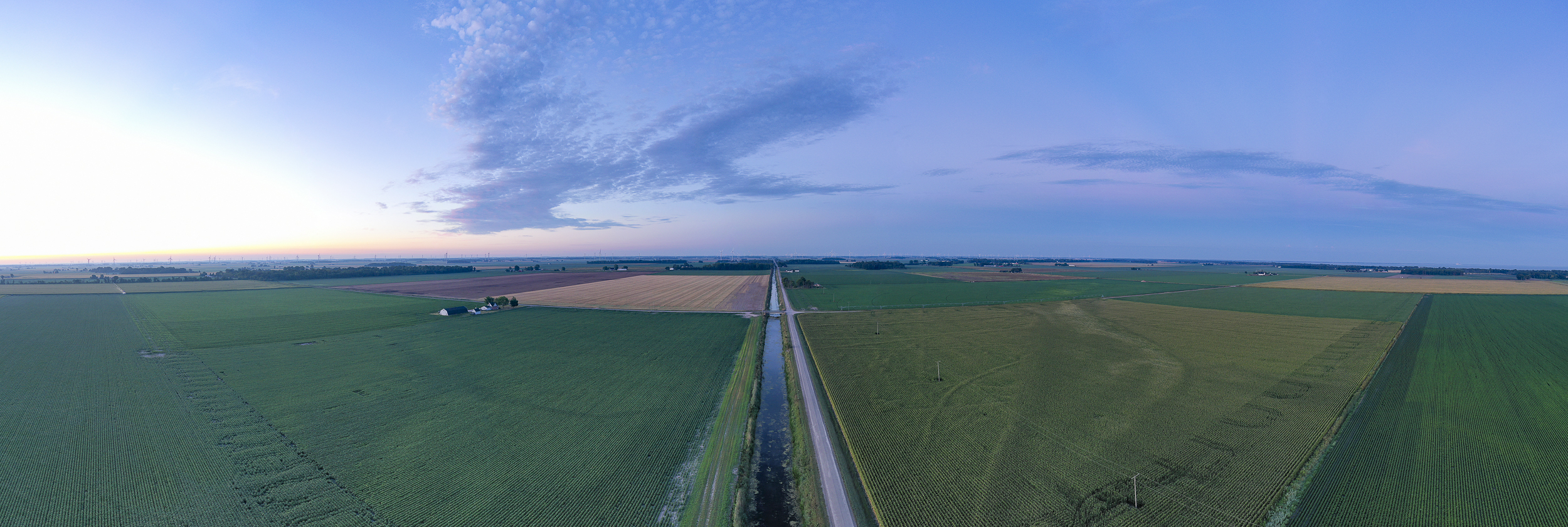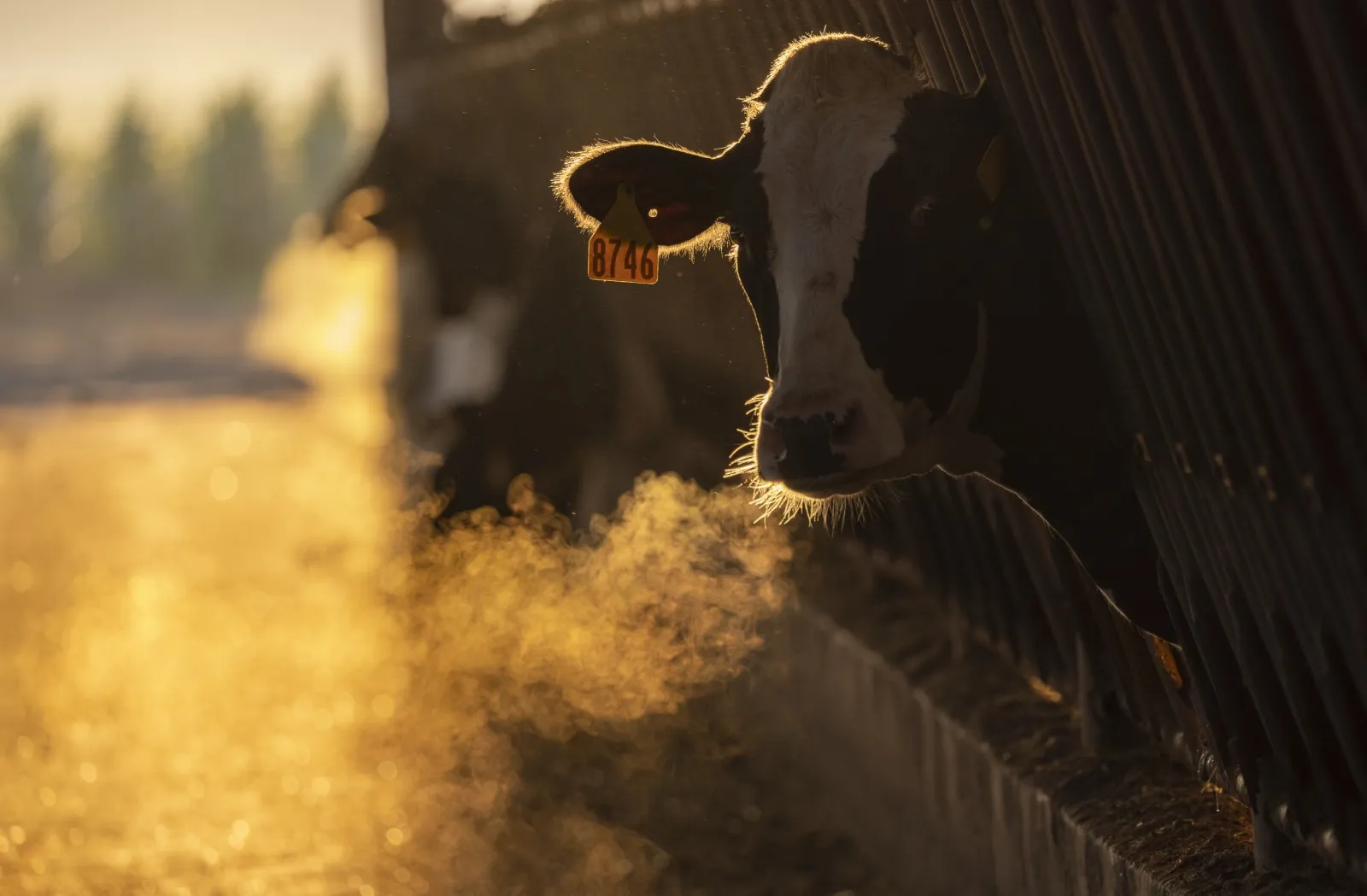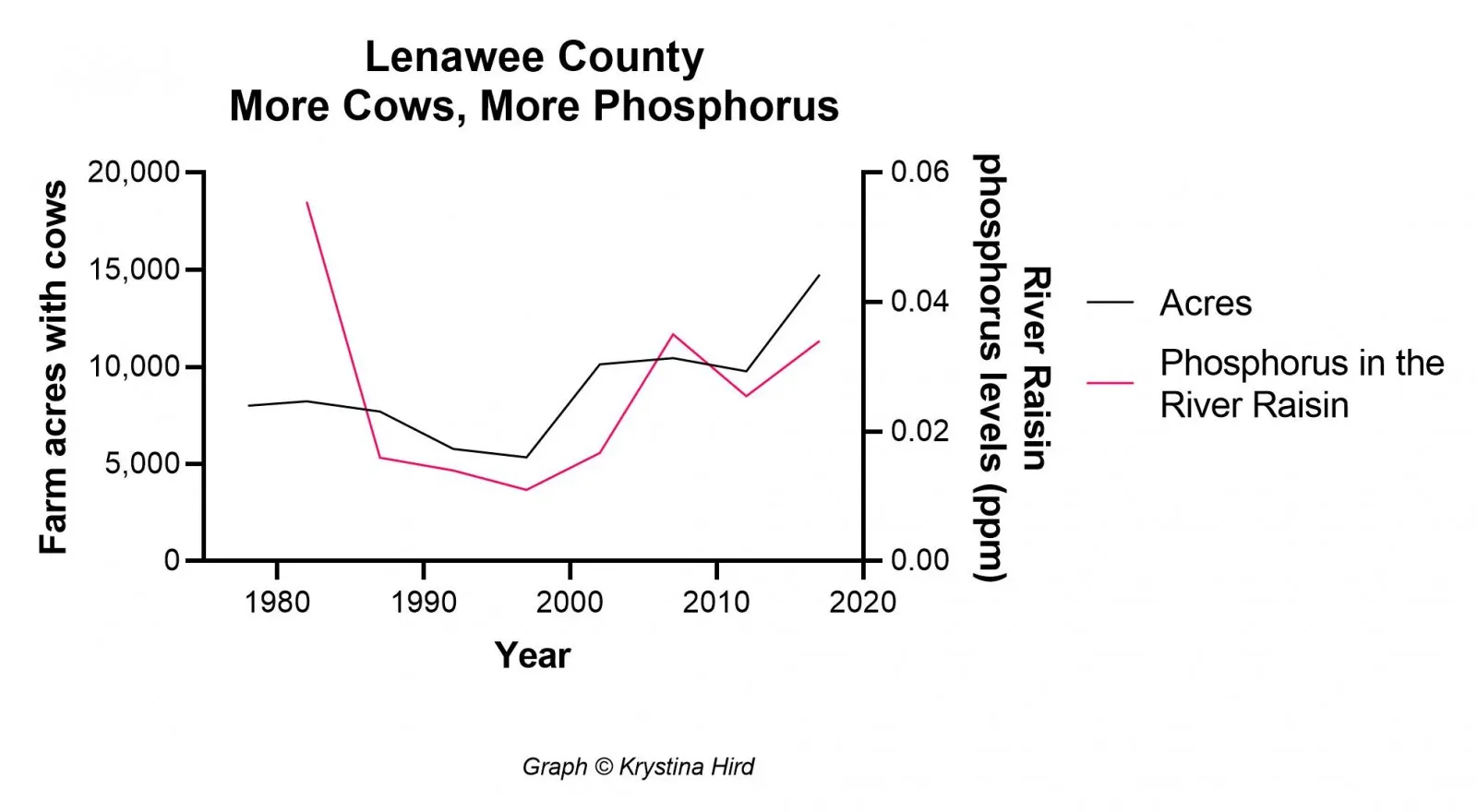
By Keith Schneider, Circle of Blue
The Great Lakes News Collaborative includes Bridge Michigan; Circle of Blue; Great Lakes Now at Detroit Public Television; and Michigan Radio, Michigan’s NPR News Leader; who work together to bring audiences news and information about the impact of climate change, pollution, and aging infrastructure on the Great Lakes and drinking water. This independent journalism is supported by the Charles Stewart Mott Foundation. Find all the work HERE.
Fifth of a six-part series. Read the first story here.
LANSING, Mich. – To a large extent the harmful algal blooms that foul Michigan’s waters and turn western Lake Erie into a toxic inland sea are the result of mismatches.
Here is one: More than $427 million in federal funds has been spent in Michigan since 2010 — $105 million in just the last two years — on voluntary bloom-reducing cultivation, fertilization, and manure-handling practices that don’t work.
That’s because phosphorus applications on farmland have increased since the early years of the century, according to a comprehensive 2022 evaluation by the U.S. Department of Agriculture. And farmers and landowners in Michigan have spent over a century and $5 billion installing tens of thousands of miles of subsurface perforated pipe while also constructing thousands more miles of deep ditches along fields. This extensive drainage infrastructure carries nutrient-rich water from 3.8 million acres of farmland and directs it into streams and rivers that terminate in the Great Lakes.
There are several more mismatches:
- Too much commercial fertilizer and liquid animal manure is being spread on too few acres, often at the wrong time of year. Phosphorus not absorbed in the soil or by crops dissolves into the soluble reactive form that cyanobacteria crave to produce toxic algal blooms;
- Most programs to curtail nutrient pollution are voluntary, relying on financial incentives paid by the federal government to convince landowners and producers to change their cultivation practices;
- The politically influential commercial farm community – a tiny minority of citizens – is primarily responsible for contaminating waters that millions depend on for drinking and recreation;
- The state’s largest livestock and poultry producers are treated as a special class of polluters. They are allowed by law and timid regulatory inertia to annually spread 400 millions of tons of solid manure, and 4 billion gallons of raw, untreated liquid animal feces and urine – 5,000 to 7,000 gallons per acre – on 600,000 acres across Michigan;
- Farmers are largely shielded from accurately reporting where nutrients and manure are spread and at what rates, making it nearly impossible to trace pollutants to a particular farm operation and assign blame. State authorities acknowledge they have no idea where half of the wastes are spread;
- Smaller livestock and poultry farms operate without any regulation to control wastes;
- Despite ample evidence of dangerous algal blooms erupting on more lakes, prompting health authorities to issue regular alarms and forcing homeowners and businesses to pay for rising drinking water purification costs, public tolerance for the blooms has insulated Michigan’s elected leaders and agency officials from establishing more vigorous and effective safeguards.
Here, though, is the biggest mismatch of all: Harmful algal blooms occur persistently in a state with sturdy and clear legal directives to lawmakers and regulators to secure Michigan’s waters. Those directives have been consistently upheld for a half century by the state’s Circuit, Appellate, and Supreme Court justices. The Michigan Constitution, ratified in 1963, states that “the natural resources of the state are hereby declared to be of paramount public concern in the interest of the health, safety and general welfare of the people. The legislature shall provide for the protection of the air, water and other natural resources of the state from pollution, impairment and destruction.”
The Michigan Environment Protection Act (MEPA), enacted by the Legislature in 1970, implements that constitutional mandate. The statute outlaws conduct that is “likely to pollute, impair, or destroy” natural resources and the environment. And it gives every citizen the authority to bring suit against polluters and government agencies that are doing just that in violation of the public trust.
“If you understand the framework in Michigan — the Constitution, MEPA, and strong public trust law — we have powerful enforcement mechanisms that other states in the Great Lakes basin, like Ohio, do not have,” said James M. Olson, one of the state’s leading environmental lawyers and founder of FLOW, a non-profit water law and advocacy group in Traverse City. “There’s no excuse for these blooms to be happening in Michigan.”

“There’s no excuse for these blooms to be happening in Michigan,” said James M. Olson, one of the state’s leading environmental lawyers and founder of FLOW, a non-profit water law and advocacy group in Traverse City.
Confrontation on New Permit
They are happening, though. For two years a confrontation over the Whitmer administration’s effort to issue new permit requirements to modestly strengthen rules for storing and spreading liquid manure from big livestock and poultry farms, is a contemporary and relevant case study of why.
On March 27, 2020, following years of research and evaluation, and months of compromise, professional staff at the Michigan Department of Environment, Great Lakes and Energy completed the final permit conditions for livestock farmers to manage manure and other wastes produced by the state’s 291 concentrated animal feeding operations, or CAFOs.
The new rules applied only to the state’s largest poultry, hog, and dairy farms. Their intent is to compel producers to adopt changes in storage and spreading practices that would go a bit further than previous rules for keeping untreated manure from reaching state waters. Every five years since 2005, Michigan has issued a general CAFO permit for the state’s largest livestock farms, where thousands of animals are confined indoors for their entire lives. The authority to do so is embedded in the federal 1972 Clean Water Act, which defined large livestock and poultry farms as “point sources” of water pollution that require permits to discharge their wastes.
In every other industry, point source permits require polluters to treat their wastes to dramatically reduce contaminants. The permitted level of phosphorus discharged by wastewater treatment plants, for instance, is 1 part per million, comparable to a single grain in a cup of sand.
CAFO operators, though, are a favored class of polluter. They are not required to treat their livestock wastes before they spread liquid feces and urine on fields. For this and other reasons, Michigan’s three previous CAFO permits had no effect on the number and risk of summertime harmful blooms that occur in Lake Erie, Saginaw Bay, Lake Macatawa, and dozens more lakes around the state. Monitoring stations show that concentrations of dissolved reactive phosphorus, the form of the mineral on which cyanobacteria thrive, are elevated in watersheds where CAFOs are located.
In addition, the federal Clean Water Act requires states to develop cleanup plans and set limits on contaminants – phosphorus and E.coli among them – so that polluted and impaired waters recover. The process for achieving that goal is called a TMDL – total maximum daily load. In establishing a TMDL, the Department of Environment, Great Lakes and Energy (EGLE) staff identify sources of contamination and set targets for reducing pollutants. A TMDL also is supposed to give regulators the authority to compel point-source polluters to reduce their foul wastes.
Michigan has established 134 TMDLs across the state. A number of them specifically deal with waters in which CAFOs contribute to pollution. Fourteen are meant to significantly reduce phosphorus contamination. Some 72 others focus on limiting E.coli, which is the dangerous intestinal bacteria associated with human and animal wastes. With the exception of requiring dairy cattle to be fenced off from streams in the Upper Peninsula, none of the TMDLs for E.coli or phosphorus in watersheds where farming is the primary use of land have yet been successful in reaching targeted levels for reducing pollution. That’s the case in Lake Macatawa, lakes in the Huron River watershed, and the six southeast Michigan counties that drain into western Lake Erie.

A state Environment Department effort to more stringently manage how large livestock operations manage and spread manure faltered under pressure from the Michigan Farm Bureau. Photo © J. Carl Ganter/ Circle of Blue
More Phosphorus Not Less
There’s a reason for that. The number of CAFOs in Michigan is increasing. There are 291 today. That’s 257 more CAFOs than Michigan permitted in 2005, according to state figures. They are larger and produce more waste.
In 2020, for instance, the 14 CAFOs in Lenawee and Hillsdale counties – 11 dairies and 3 hog operations – spread 221.4 million gallons of liquid manure and nearly 100,00 tons of solid manure on 14,650 acres of farmland, according to the state. That’s a sizable increase from 2015, when the two counties’ CAFOs spread 170 million gallons and almost 93,000 tons on roughly the same amount of farmland.
In addition, CAFO operators are allowed to sell, give away, and spread manure on fields they don’t farm and are not in their “operational control.” Operators are required to “manifest” or document the quantity and location where waste is spread. In 2020, according to state figures, 85.3 million more gallons of liquid waste and 50,000 more tons of solid waste were manifested in the two counties. The total number of acres and location of manifested waste is not known. EGLE has not compiled records for manifested waste for 2015.

Data: U.S. Department of Agriculture 2017 Census and U.S. Department of Agriculture Publications and National Center for Water Quality, Heidelberg University
The same trend of increasing quantities of manure is occurring throughout Michigan and in the other Great Lakes states, all of which are contending with harmful algal blooms. The USDA spends $8.2 million a year on a research group – the Conservation Effects Assessment Project (CEAP) – to evaluate how well the more than $5 billion a year that the agency spends on conservation is performing. The research team is interested in soil erosion, whether farms are embracing more ecologically sensitive cultivation practices, and how much nitrogen and phosphorus drain from farm fields.
In March 2022 CEAP released its latest national assessment. It found that environmentally sensitive approaches to producing the nation’s food were being embraced by a few more farmers and that ecological damage was diminishing — with one important exception. The amount of phosphorus — especially dissolved reactive phosphorus — draining into streams was increasing. The CAEP researchers found that phosphorus applications increased to 18.6 pounds per acre on average in 2016 from 16.2 pounds in 2006. That’s a 15 percent increase.
Among the highest increases in phosphorus application occurred in Michigan, Ohio, Wisconsin and the four other states of the upper Middle West. “The geographic separation of livestock from cropland drove a nutrient imbalance between the two,” said the report’s authors, “reducing opportunities for manure nutrients to be used productively, and creating incentives for overapplication of manure nutrients as a waste disposal solution.”
In July 2022, the International Joint Commission issued its latest assessment of progress in meeting U.S.-Canada goals for clearing the Great Lakes of contamination. It also found discouraging trends for phosphorus and algal blooms. “To date, there is no evidence of a declining trend in phosphorus loads,” wrote the report’s authors.
The Whitmer administration and state environmental regulators are well aware of these trends. In 2014, many of those EGLE staff members provided the technical details underlying Republican Gov. Rick Snyder’s commitment with Ohio, Indiana, and Ontario to reduce Lake Erie’s phosphorus load by 40 percent by 2025.
In December 2021, in collaboration with the state Department of Agriculture and Rural Development, EGLE and Gov. Whitmer issued an action plan to meet the 40 percent goal by reducing annual phosphorus discharges into Lake Erie from Michigan by 376 more metric tons. Almost all of it – 249 metric tons — comes from Lenawee and the five other Michigan counties that drain into western Lake Erie.
Motivated by work they’d already done to try and cut phosphorus, EGLE staff viewed a more protective CAFO permit as an essential feature of the basin-wide plan to curb Lake Erie’s algal blooms. The permit also would play an important role in achieving TMDL goals for other Michigan watersheds that call for sharp reductions in concentrations of phosphorus in streams and lakes.

Data: https://agcensus.library.cornell.edu/ and https://www.nass.usda.gov/Publications/AgCensus/2017/Full_Report/Volume_1,_Chapter_1_US/
But the permit EGLE ended up issuing in 2020 was a timid advance on three previous CAFO permits. In fact, it looked a lot like its predecessors. It called for storage lagoons large enough to hold six months of waste, with sufficient room to also account for extra water from storms. Farmers were directed to conduct weekly inspections of manure handling equipment, correct deficiencies, maintain reports, and alert the state to any problems.
It required farmers to develop and adhere to nutrient management plans, and report to the state the location and condition of every field eligible to receive liquid wastes.
Farmers were directed to apply phosphorus without exceeding the capacity of the soil to assimilate the waste, and furthermore to inspect fields and drains before and after applications. It required farmers to plant a permanent 35-foot-wide buffer along streams, and not to apply wastes nearer than 100 feet to any surface waters.
But the permit largely punted on the most significant facets of controlling phosphorus.
First, it continued to allow CAFO operators to pour liquid manure on fields already saturated with phosphorus. They were directed to stop only when phosphorus soil concentrations in fields exceeded 120 to 135 parts per million, depending on where they are located. EGLE staffers assert that is less than the 150 parts per million limit of previous permits. But even so, the new limits are six times higher than what growing crops in Michigan need. Agronomists agree that 20 to 40 parts per million of soil phosphorus is more than adequate to produce bountiful grain harvests. Field specialists at Michigan State University conclude that at least half of the state’s farm fields don’t need any new phosphorus applications at all.
And second, the new permit still allows CAFOs to spread wastes in winter, with some aimless new restrictions. If snow and frost are below certain levels, the 2020 permit requires CAFO operators to alert EGLE to manure spreading, and wastes must be incorporated immediately into soil. But the powerful weight of scientific consensus is that winter is the worst time to spread wastes, regardless of how it’s done, because frozen ground acts like a sluice directing nutrients off the land and into the water. In 2015, even Ohio prohibited spreading manure on snow-covered or frozen ground in the Western Lake Erie Basin.
In effect, EGLE’s 2020 permit reflects the influence in Lansing of the state’s $100-billion-plus agriculture sector, and of CAFO operators in rural counties. As with the three prior permits, the agency again authorized CAFOs to treat farm fields as depots for untreated wastes.
Compromise Sought, More Pollution is Result
How this happened is a study in what the Whitmer administration and EGLE officials assert is a political compromise. The department issued the permit after holding a series of public meetings, and after responding to over 100 comments. Regulators also met privately with farmers and farm organizations. In one such hearing, Christine Alexander, EGLE’s permits section manager, said: “The department wanted to be responsive to the feedback we received from industry, so we tried to take reasonable steps to address water quality impacts while not being overly burdensome for the industry.”
The department’s palms-up, arms-extended hug to the farm sector utterly failed to impress CAFO operators. On May 27, two months to the day after the permit was issued, Michigan Farm Bureau, six other farm associations, and 165 CAFO operators filed a formal petition to contest the new permit. The groups asserted the new provisions were “costly and cumbersome,” had a “tenuous relation to water quality,” are of “minimal environmental benefit,” would have “a significant adverse impact on food production,” and are unlawful because EGLE does not have the authority to issue them.
Laura Campbell, Michigan Farm Bureau’s chief policy specialist, declined to be interviewed for this article. The Farm Bureau’s May 27 petition said that EGLE “has imposed these substantial costs on Michigan’s largest family farms during a time when our country’s health and economy have been ravaged by COVID-19 and our dependence on such farms to provide an abundant, stable, and healthy food-supply system is even greater than ever.”
Days later, without even having to be asked, EGLE stayed the new provisions from going into effect, a decision tantamount to putting a temporary restraining order on its own rules while an administrative law judge considers the merits of the Farm Bureau opposition.
Environmental advocates call the weakened permit and the stay of execution an outrageous act of cowardice. “It’s terrible,” said Rob Michaels, an attorney for the Environmental Law and Policy Center (ELPC), a Chicago-based legal group, who is working to strengthen the permit. “It is an indictment of the political system from top to bottom that this has been allowed to continue and that the tools in the toolbox are as limited as they are.”
In November 2021 ELPC and Lenawee County’s Environmentally Concerned Citizens of South Central Michigan, plus five other non-profit state and regional environmental organizations formally intervened in the contested case hearing. Their legal briefs aggressively counter the Farm Bureau’s arguments and make the case that the new permit is not nearly sufficient to meet water quality standards and the requirements of state law. The seven nonprofits call for the new permit to be substantially strengthened, including banning waste application in the winter, barring application of liquid waste to tile-drained fields, and requiring sampling and testing of all observed discharges to surface water.
In June 2022, Dana Nessel, Michigan’s attorney general, also submitted a brief in the case that essentially argues that EGLE was well within its responsibilities and the law in issuing the permit. “Under the age-old public trust doctrine, as well as contemporary federal and state law, the Michigan Department of Environment, Great Lakes, and Energy is bound to protect Michigan’s water from harmful pollution,” said Nessel.
An administrative law judge is reviewing the arguments and will make a decision, likely before year’s end. Whatever the judge decides, the Farm Bureau’s strategy to impede even modest new restraints on manure spreading will have achieved much of its purpose. It’s been more than two years since the permit was issued. Any ruling is likely to prompt one side to appeal, potentially delaying a final decision another two years.
Summed up, the old and inadequate 2015 permit requirements could remain in effect until 2025 when EGLE is required to write another CAFO general permit, putting in further jeopardy the state’s commitment to achieve a 40 percent reduction in phosphorus by that date.
Project credits:
Krystina Hird served as a researcher for this project. Hird is a PhD candidate in the Biochemistry and Molecular Biology program at MSU. Her research project focuses on understanding the mechanism of reducing nitrite to ammonium via bacterial cytochrome c nitrite reductase.
Dr. Laura T. Johnson, director of the National Center for Water Quality Research at Heidelberg University, served as a science advisor for this project.
Catch more news at Great Lakes Now:
Lake Erie’s Failed Algae Strategy Hurts Poor Communities the Most
In A Year of Water Quality Reckoning, National Imperative is Impeded
Featured image: Photo © J. Carl Ganter/ Circle of Blue
1 Comment
-
This was a well researched, extremely well written article!




